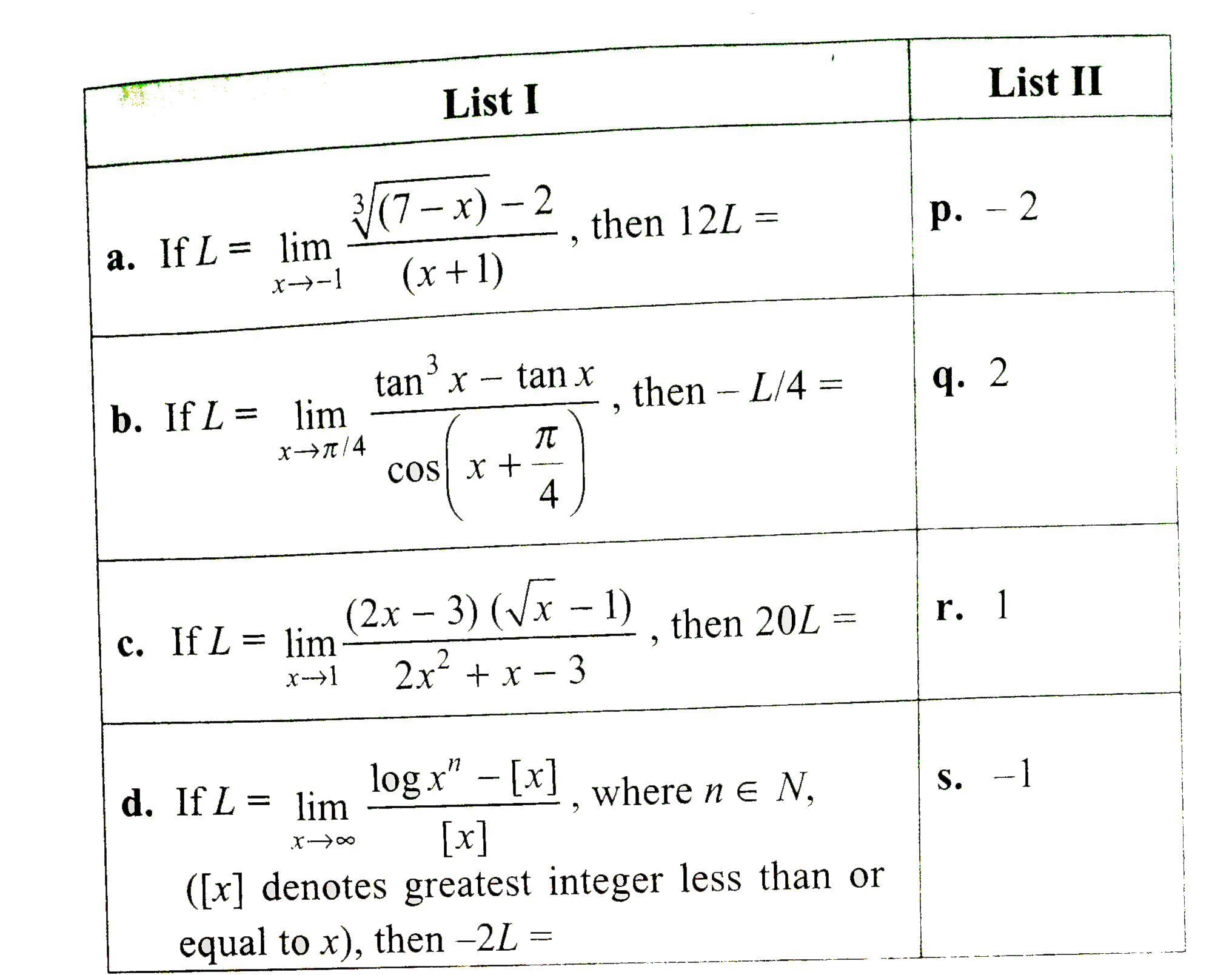Letf(x)=sin−1(1−{x})×cos−1(1−{x})√2{x}×(1−{x}), where {x} denotes the fractional part of x.
L=limx→0−f(x) is equal to Solution in Bengali
The correct Answer is:D
We have f(x)=sin−1(1−{x})cos−1(1−{x})√2{x}(1−{x})
∴limx→0+f(x)=limh→0f(0+h)
=limh→0sin−1(1−{0+h})cos−1(1−{0+h})√2{0+h}(1−{0+h})
=limh→0sin−1(1−h)cos−1(1−h)√2h(1−h)
=limh→0sin−1(1−h)(1−h)limh→0cos−1(1−h)√2h
In second limit, put 1−h=cosθ. Then
limx→0+f(x)=limh→0sin−1(1−h)(1−h)limh→0cos−1(cosθ)√2(1−cosθ)
=limh→0sin−1(1−h)(1−h)limθ→0θ2sin(θ/2)(∵θ>0)
=sin−11×1=π/2
and limx→0−f(x)=limh→0f(0−h)
=limh→0sin−1(1−{0−h})cos−1(1−{0−h})√2{0−h})(1−{0−h})
=limh→0sin−1(1+h−1)cos−1(1+h−1)√2(−h+1)(1+h−1)
=limh→0sin−1hhlimh→0cos−1h√2(1−h)
=1π/2√2=π2√2
Topper's Solved these Questions
- LIMITSBook:CENGAGE PUBLICATIONChapter:LIMITSExercise:Matrix Match Type
Explore 5 Videos
- LIMITSBook:CENGAGE PUBLICATIONChapter:LIMITSExercise:Numerical Value Type
Explore 26 Videos
- LIMITSBook:CENGAGE PUBLICATIONChapter:LIMITSExercise:Exercises (Single Correct Answer Type)
Explore 76 Videos
- JEE 2019Book:CENGAGE PUBLICATIONChapter:JEE 2019Exercise:Chapter 10
Explore 8 Videos
- LINEAR COMBINATION OF VECTORS, DEPENDENT AND INDEPENDENT VECTORSBook:CENGAGE PUBLICATIONChapter:LINEAR COMBINATION OF VECTORS, DEPENDENT AND INDEPENDENT VECTORSExercise:DPP 1.2
Explore 10 Videos
Similar Questions
Match the following lists:

View SolutionThe reciprocal of the value of: limn→∞(1−122)(1−132)(1−142)(1−1n2)is
View Solutionlimx→0[sin(sgn(x))(sgn(x))], where [.] denotes the greatest integer function, is equal to
View SolutionIf y = y(x) is the solution of the differential equation, xdydx+2y=x2 satisfying y(1) = 1, then y(12) is equal to
View SolutionThe number of integral values of p for which (p+1)ˆi−3ˆj+pˆk,pˆi+(p+1)ˆj−3ˆk and −3ˆi+pˆj+(p+1)ˆk are linearly dependent vectors is q
View SolutionConsider the function f(x)=(cos^(-1)(1-{x}))/(sqrt(2){x}); where {.} denotes the fractional part function,then
View SolutionDomain of f(x)=(1)/(sqrt({x+1}-x^(2)+2x)) where {} denotes fractional part of x.
View Solutionlet f(x)=(cos^(-1)(1-{x})sin^(-1)(1-{x}))/(sqrt(2{x}(1-{x}))) where {x} denotes the fractional part of x then
View SolutionIf f(x) = ex, then limx→0(f(x))1{f(x)} (where { } denotes the fractional part of x) is equal to -
View Solution(lim)x→11√|x|−{−x}(where{x} denotes the fractional part of (x) is equal to does not exist (b) 1 ∞ (d) 12
View SolutionLetf(x)=sin−1(1−{x})×cos−1(1−{x})√2{x}×(1−{x}), where {x} denotes the fractional part of x.
L=limx→0−f(x) is equal to
View SolutionLet f(x)=[x]+√{x}, where [.] denotes the integral part of x and {x} denotes the fractional part of x. Then f−1(x) is
View SolutionThe value of limx→0(tan({x}−1))sin{x}{x}({x}−1) is where {x} denotes the fractional part function
View SolutionLet f(x)={π2−sin−1(1−{x}2).sin−1(1−{x})√2({x}+{x}3),x≠0, where {.} is fractional part of x, then
View Solutionlimx→−11√|x|−{−x} (where {x} denotes the fractional part of x) is equal to
View SolutionLetf(x)=sin−1(1−{x})×cos−1(1−{x})√2{x}×(1−{x}), where {x} denotes the fractional part of x.
R=limx→0+f(x) is equal to
View Solution